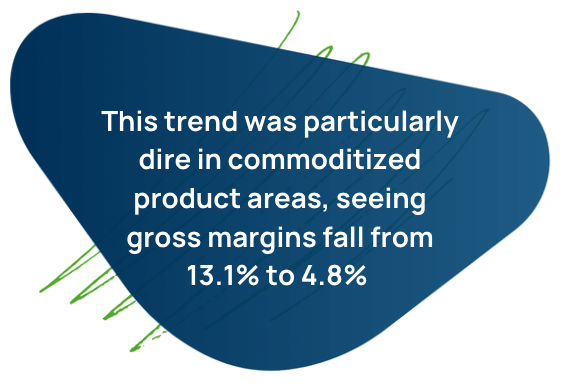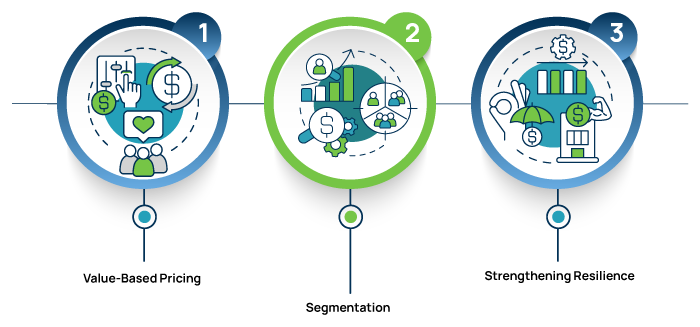
Chris Kennedy-Sloane, Business Consultant at Vendavo illustrates how to drive profitability in chemicals manufacturing while navigating the complexities of the marketplace and improving your pricing processes.
So the question is, is compounding business complexity degrading profitability in chemicals manufacturing? If that question resonated with you, you’re not alone.
Already ten years ago, Deloitte was reporting that across the roughly 250 existing chemical and materials companies globally over the preceding 15 years, gross margins have fallen an average of 4.4%. This trend was particularly dire in commoditized product areas, seeing gross margins fall from 13.1% to 4.8% over that same period.
These trends appear to have continued, and in some cases accelerated, with the increasing complexity of chemicals manufacturing causing reductions in R&D spend and creating a vicious cycle of reliance on volatile inputs.

With most chemicals manufacturers representing a stratified portfolio of businesses, selling products at all levels of the value chain, many still return to traditional cost plus or index linked pricing to set their pricing strategy. This tail-wagging-the-dog pricing input runs a real risk of further commoditizing output products as the combination of client-based pricing pressure, technological advancements simplifying production, and new competitors entering the marketplace drives market pricing ever lower.
The increased volatility linked to current trading conditions means that feedstock and energy prices for manufacturing these commodity products is becoming more impactful as a percentage of total product manufacturing costs, further intensifying the impact that these cost-based pricing strategies have on actual market pricing. This is highly visible in US import chemical price indexes with the steady fall of recent years at -1.9% index (Dec 2018 to Dec 2019) swiftly inverted as the recovery from the Covid pandemic and the war in Ukraine have strained supply chains and energy supply networks, now running at +11.3% index (Dec 2018 to Dec 2021).
Furthermore, markets themselves can change swiftly. Consider, for example, the lifetime of consumer drilling machines, reliant on and composed of a significant number of plastics products. Their actual usage by consumers is often measured in minutes rather than hours or days. As manufacturers, retailers and users of these machines move towards the potential to offer ‘drilling as a service’ in DIY stores, there is potential for these to be utilized many thousands of times longer than they are now, significantly reducing the demand for manufacturing. To make up for the impact of plastics products, it would behoove chemicals companies to instead pivot to providing solutions that improve durability, rather than volume or manufacturing costs. Disruptions such as this can occur quickly and without warning.
How to Navigate the Complex Marketplace and Avoid the Risks of Losing Input to Your Pricing Processes

1. Value-Based Pricing
Practically, most pricing professionals, salespeople and even c-suite understand what they need to do to maximize the value from their manufactured chemical products. Linking customer realized value to the price they’re charging is key, and a robust and agile value-based pricing program is generally understood to be the best way to do this. However, in an environment where inputs, outputs, markets and consumers are changing so rapidly, it can be very difficult to create and maintain these pricing strategies. When the going gets tough, there is a tendency to fall back to those simpler strategies due to the difficulties in adjusting and testing these strategies.
This is where a software solution is key. Introducing dynamism to the business rules which dictate pricing on the basis of data inputs, and ensuring that this dynamism is structured so that it is resilient to market change, frees up the pricing team to concentrate on managing and improving the strategies they are espousing. This automation is imperative in this rapidly changing environment, and the ability to engender trust in the pricing system and consequently the pricing team is needed to ensure that the sales organization and senior management are fully on-board with the overarching strategy.
2. Adding Discretion Through Segmentation
With a strong base which can maintain prices across the complex product portfolio and value differentiation, this then allows the introduction of customer segmentation and even individual deal price optimization to further compound the gains realized from value based pricing. Doing this manually is possible, but again it is the maintenance and adjustment of these segments and deal guidance over time which can become overly onerous. This again leads to the tendency to simplify in order to reduce workload – Inevitably leaving money on the table as the ‘ideal’ level of discrete gives way to the ‘practical’.
But, a purely software based segmentation tends to go the other way. A completely data-driven segmentation may be extremely discrete, but it is extremely difficult for your average human to understand. It’s even more difficult to explain to your colleagues in sales or marketing why a particular segment makes sense, with the argumentation of ‘The computer says this is the way we’ll make the most money’ often getting short shrift. These black-box solutions often fail to build trust, and consequently buy-in and realized value.
Here, a combination of software suggested segmentation alongside human interpreted understanding can get the best of both worlds. ‘Soft data’ which represents our potential understanding of marketplaces, challenges, trends and other pieces of information that would be extremely difficult to integrate into a model can be interpreted into it alongside a machine interpretation of pricing power and pricing risk. This means that the results can be justified, with data to support them, and also manipulated positively to ensure that exceptions and peculiarities that a pure data driven model would create are removed. This builds trust, adoption and buy-in.
3. Resilience as a Foundational Principle
The final piece of the puzzle is the risk of static value-based pricing and segmentation structures becoming out-of-date. These models naturally tend to use backwards looking data, meaning that the ‘signal delay’ causes the need for frequent refreshes to capitalize on the most potential value. One way to solve this problem would be to be able to forecast future trends and market conditions accurately. However, it’s fair to say that any pricer will understand only too well how difficult this is to do with any degree of precision.
This is where we come back once more to the dynamism of our business rules and our pricing system. The more scenarios of our data inputs, calculations and conclusions we can successfully bound and capture within the pricing system, the more frequently we can update our value based list pricing, customer and market segmentations, and specific customer and even deal based pricing guidance.
With the continued growth and advent of data-driven process manufacturing alongside IOT integration, more datapoints can be tied into our pricing models. This in turn allows the linking of capacity and yield to demand and consequently price. Each piece of accuracy here is cumulative, driving a more accurate link between pricing and value to our customers.
How Vendavo’s Solutions Help Chemical Manufacturers
Vendavo’s pricing solutions help some of the largest chemical manufacturers in the world make this form of pricing look easy. Many of Vendavo’s chemical manufacturing customers implement our entire solution stack, allowing them to drive formula-based pricing through any number of custom datapoints with Pricepoint, designed for managing and optimizing prices. These in turn can feed directly into Intelligent CPQ, managing customer agreements alongside those specific derived formulae and ensuring that the complex and ever-changing nature of chemical process price agreements is handled as a matter of course.
Vendavo’s solutions make complex, big-data landscapes easy to interpret and use to drive value-based outcomes, providing a win-win situation where your customers get a price which reflects the value they derive from your products and you ensure your business needs are met by improved revenue and margins.
Take a look at one of our case studies for a more in depth example of how Vendavo helps chemicals manufacturers develop and improve commercial excellence. If you think Vendavo could help you too, don’t hesitate to contact us today to request a demonstration.
